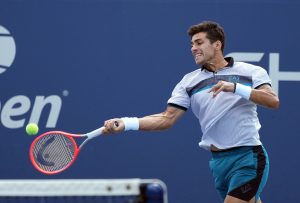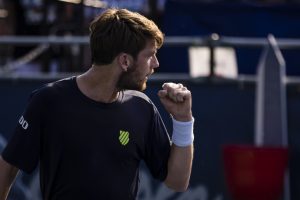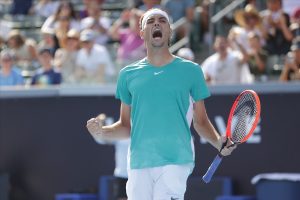This week, Petra Kvitova, the two-time Wimbledon champion, used Instagram to update her fans and the wider world of her progress after suffering appalling injuries to her left hand (the hand with which she holds a racket) during a break-in at her home in the Czech Republic just before Christmas. Although unable to give a specific date for her return to the women’s tour, she confirmed that she was recovering well and “working really hard” to maintain her all-round fitness. In particular, she said that the attack had altered her whole approach to tennis: “I realized while I’ve been away how much I like challenges! My perspective on life has changed a lot and I am doing everything to give myself a second chance to be back on the court.”
“Second chances,” of course, are the staple of so many stories, in particular Hollywood stories, and Kvitova is certainly not the first tennis player who has only truly realized what they possess–immense natural talent and an opportunity to make a great living from it–when they have come close to losing it. If she does complete a successful comeback from injury, especially one sustained in such difficult circumstances, it will be one of the finest in the history of the game. For now, though, these are the five greatest comebacks from injury in tennis history.
- VENUS WILLIAMS REACHING THE AUSTRALIAN OPEN 2017 FINAL
In the case of Venus Williams, it was not injury as such that laid her low but debilitating illness. She was originally diagnosed with Sjögren’s Syndrome (a viral illness with the suitably awful abbreviation of “SS”) in 2011. The elder of the two brilliant Williams sisters had struggled with extreme fatigue for several years before then, which almost certainly accounts for the steep fall-off in her results after winning her fifth and final Wimbledon title (and her seventh Grand Slam singles title in total) in 2008. At least the diagnosis of the illness provided an explanation as to why the greatest grass-court player of her generation (as Venus undoubtedly was, up until her illness) had become almost Bambi-like in her vulnerability, at Wimbledon and seemingly everywhere else.
Nature abhorring a vacuum, Venus’s younger sister, Serena, filled the gap left by Venus at the top of the women’s game. Indeed, it is arguable that Serena’s astonishing success late in her career is at least partly due to the virtual disappearance of her sister as a major rival. Venus continued to play, of course, and such was the remarkable power of her serve and ground strokes, even after they had been severely sapped by injury, that she remained a threat, but it was nearly a decade before she returned to her rightful place at the top of the women’s game.
The comeback came, utterly unexpectedly, at this year’s Australian Open, when Venus seemed to cast off the effects of her illness and went on a devastating run that took her all the way to the final, defeating the likes of Anastasia Pavlyuchenkova and Coco Vandeweghe, who are both more than a decade younger than her, on the way. Sadly, the fairy-tale comeback was not to be capped with another Major title, as Serena beat her older sister yet again in a Slam final (for the seventh time in nine such finals). However, Venus was not only genuinely thrilled to have made another Major final but she knew that if she had played anyone other than Serena she would probably have won.
- MARK PHILIPPOUSSIS REACHING THE WIMBLEDON FINAL AND HELPING AUSTRALIA TO WIN THE DAVIS CUP IN 2003
The fact that Mark Philippoussis’s full name is “Mark Anthony Philippoussis” should have given the world a clue as to the imperial nature of his tennis when he was at his best. In particular, his phenomenal serve, timed at its fastest in 1997 at over 142 mph, earned him the short but accurate nickname of “Scud,” as in Scud missile (America’s weapon of choice in the first Gulf War of 1991).
The sheer power of Philippoussis’s game (his ground strokes were almost as forceful as his serve) helped him to move quickly up the rankings after turning pro in 1994, and it was only four years later that he reached his first Major final, the 1998 US Open final. It was an all-Australian affair that his compatriot Pat Rafter won in four sets to take his second successive American crown.
Then, however, Philippoussis’s apparently endless knee problems began, starting with a retirement in the second set of his 1999 quarterfinal against Pete Sampras, after he had won the first and genuinely looked like ending Sampras’s supreme run at SW19. Keyhole surgery on his left knee followed and he missed most of the rest of the season. Incredibly, however, Philippoussis ended the year on a high, as he won the deciding rubber in Australia’s Davis Cup final against France, which was held in France and on clay, undoubtedly his worst surface.
That success, however, was very much the exception to the rule of the next few years, the rule being that Philippoussis suffered numerous problems with his left knee and had to undergo three more major operations. Effectively, doctors had to rebuild his left knee before he could even contemplate returning to the top of the game.
Philippoussis’s unlikely comeback came in 2003, when he recovered from knee problems sufficiently to rededicate himself to tennis, in the same way that Petra Kvitova is doing now. Free from injury for the first time in years, Philippoussis could ramp up his magnificent serve once again, and it took him all the way to the Wimbledon final, where he was unfortunate to meet Roger Federer in his first Grand Slam final (the first of 28, to date). Nevertheless, he finally achieved sporting redemption later that year when he again secured Davis Cup victory for Australia, this time against Spain, and once again won the rubber that secured victory. This victory was even sweeter than in 1999, as it was achieved in the Rod Laver Arena in Melbourne, the home of the Australian Open. Although Philippoussis would never go on to win the Grand Slam that his talents, and particularly his serve, deserved, this was a very acceptable substitute.
- JUAN MARTIN DEL POTRO REACHING THE OLYMPIC FINAL AND HELPING ARGENTINA TO WIN THE DAVIS CUP FOR THE FIRST TIME IN 2016
The parallels between Mark Philippoussis and Juan Martín del Potro are extraordinary. Both men are gigantic servers; both men suffered excruciating injuries that nearly forced them to quit the game; and both men ultimately achieved a great sporting comeback by helping their country to win the Davis Cup. However, del Potro’s achievements are even more impressive than those of Philippoussis, in that he actually won the US Open (rather than just reaching the final), he spent even longer out of the game through injury than the Australian, and when he finally won the Davis Cup for Argentina it was Argentina’s first ever success in the tournament. Above all, del Potro was the better all-round player of the two, allying supreme touch and feel to the sheer power of a big serve in a way that was ultimately beyond Philippoussis.
Like Philippoussis, del Potro broke through early in the men’s game, but he went one step better than the Australian by winning the 2009 US Open. That was a truly historic achievement, because to this day he remains the only man to have beaten both Rafa Nadal and Roger Federer at the same Grand Slam tournament, doing so in the semifinal and final respectively. It was especially impressive because at the time Roger and Rafa were probably at their absolute best, before injury and age took their inevitable toll on them. Having beaten them both, it seemed certain del Potro would win many Majors.
Alas, it was not to be, as a succession of injuries to both his wrists – mainly to his right, with which he holds the racket, but also to his left – robbed him of the incredible power and dexterity with which he had triumphed in New York. Like Philippoussis before him, he slid down the rankings and after a series of ultimately unsuccessful comebacks it appeared that he would only ever be remembered as a “One Slam Wonder”, although, arguably, the greatest “One Slam Wonder” of all, having defeated Federer and Nadal at the same event.
Then, miraculously, came the annus mirabilis of 2016. Del Potro had undoubtedly adapted his game to cope with the weakness of his wrists, principally by playing a sliced back-hand rather than the powerful orthodox back-hand with which he began his career, but his greater experience and, above all, his renewed love of the game after injury, enabled him to have an extraordinary 12 months. Although he could not quite match the highs of 2009, he still made the Olympic final in Rio, losing an epic four-set match to Andy Murray, then won his first main tour title for years, the Stockholm Open (beating John Isner and Gregor Dimitrov on the way), before ending the year with the sweetest victory of all.
Prior to their triumph last December, Argentina were probably the greatest tennis nation never to have won the Davis Cup. The homeland of Guillermo Vilas, José Luis Clerc and David Nalbandian had reached four finals before 2016 but lost them all. Hopes were not high going into the final, especially as it was away in Croatia and the hosts could boast both a Grand Slam Champion of their own, in Marin Cilic (and one of much more recent vintage than del Potro), and a giant server of their own, in Ivo Karlovic. Nevertheless, del Potro led Argentina to victory, winning both his singles matches against Cilic and Karlovic, to complete a magnificent seven-year comeback from injury after winning the US Open as a mere 20-year-old.
- ROGER FEDERER WINNING THE AUSTRALIAN OPEN IN 2017
Comebacks are the greatest stories in sport and perhaps in life itself, and comebacks from injury, as opposed to from a lack of form or even retirement, are perhaps the most remarkable comebacks of all, because they represent a comeback from the greatest opponent that any sportsman or woman can face – their own physical fragility. What makes Roger Federer’s comeback to win the Australian Open this year so truly astonishing is that he not only overcame the relative decline of his own body but, in doing so, defeated the greatest rival that he has ever faced, Rafael Nadal.
Among Federer’s many apparently inhuman characteristics for most of his career has been his ability to avoid serious injury. In part, this was because his incredible ability to move around a tennis court, gliding where others like Nadal galloped or even galumphed, greatly reduced the impact of different surfaces on his body. Consequently, he was able to set one of his many apparently unbeatable records by playing in a record (and, frankly, scarcely believable) 65 successive Grand Slam tournaments, from the Australian Open in 2000 onwards, until he finally had to withdraw from the French Open in 2016.
However, when serious injury finally befell Federer, it did so in an almost pathetic fashion, as he first suffered a serious knee injury and then truly proved himself to be mortal (and on the verge of middle age) by injuring his back while lifting one of his children out of the bath. As a result, when he lost the 2016 Wimbledon semifinal to Milos Raonic, finally succumbing in five sets to the younger man, he called a halt to his season halfway through and effectively disappeared from the tennis circuit for six months. After so long without serious injury, it was as if all the injuries he had somehow avoided throughout his career had come at once, and there was genuine fear that he might never return to the tennis court, at least not in the imperious manner that he had bestrode it for a dozen years.
What followed, of course, is already the stuff of legend, and a comeback to match those of Muhammad Ali, after he had been banned from boxing for refusing to fight in the Vietnam war, and Pele, after he had been kicked out of the 1966 World Cup in England but came back to win the World Cup in Mexico four years later. Federer’s performance in the whole tournament was phenomenal, but it was most phenomenal in the final against Nadal when he was a break down in the final set. Then, Fed rose from the dead to win five successive games and claim the title. His 18th Grand Slam victory, which entailed his defeating Nadal in a Major final for the first time in more than a decade, sealed his legendary status, ensuring that he will not only be regarded as the finest tennis player of all time but as one of the very finest sportsmen or women in the whole of sport.
1.MONICA SELES WINNING THE AUSTRALIAN OPEN IN 1996
The greatest comeback from injury in tennis history, greater even than that of Federer in Australia this year, was that of Monica Seles in 1996, when she won the Australian Open for the fourth time, nearly three years after being stabbed on court by a deranged fan of Steffi Graf who wanted to end Seles’s challenge to Graf at the top of the women’s game.
Even now, nearly a quarter of a century on, it is hard to fully appreciate how awful this attack must have been for Seles. Her “injury” was not really an injury at all, but the result of a premeditated attack on a tennis court. And it is the scene of the crime that is so important. Petra Kvitova was also stabbed, but that wounding was not premeditated (she had interrupted an intruder or burglar, who then lashed out at her) and it took place in the relative safety and privacy of her own home. By contrast, Seles was attacked on the world stage, in front of the world’s cameras, and was almost killed.
Tennis players often talk of the court as their true home, where they feel safest or most at ease. For Seles, a tennis court could never have felt the same again after her attack and it is truly amazing that she managed to play tennis again, let alone win another Grand Slam title.
It took her more than two years of extensive physical and no doubt mental rehabilitation to return to the women’s tour. In that time, she lost not only her World No.1 ranking but the aura of dominance that she had established in the early 1990s, when she had won eight Major titles in just under three years and overtaken Steffi Graf as the world’s best player. When she finally returned to the tour in the summer of 1995, it was inevitable that she was not the same player that she had been before. As even the greatest champions know, once you have lost your aura of invincibility, it is almost impossible to regain it.
It is that background that makes Seles’s triumph at the 1996 Australian Open the greatest comeback from injury in tennis history. Whereas the other players on this list only had to overcome physical problems, such as injury or illness, she had to overcome what must have been a million mental demons. Consequently, when she won in Melbourne against Germany’s Anke Huber in straight sets, it was a truly monumental achievement.
In the Hollywood version of the story, Seles would have gone on to regain all her former glory, titles and power, but of course real life is not Hollywood. The fact is that Seles never won another Grand Slam title after Australia in 1996, reaching two more Major finals but losing them both. Nevertheless, in a way this makes her story all the more incredible. She may never have been able to regain her former greatness completely, but the fact that she regained any of it, after what she went through – something that no other tennis player, not even Petra Kvitova, has had to endure – is truly remarkable and sets her apart from any other player, male or female, in the history of tennis.
Enjoy articles looking back at all-time best players and tennis history in general? Make sure to check out our page devoted to stories appreciating historic achievements in tennis.
Main Photo:






